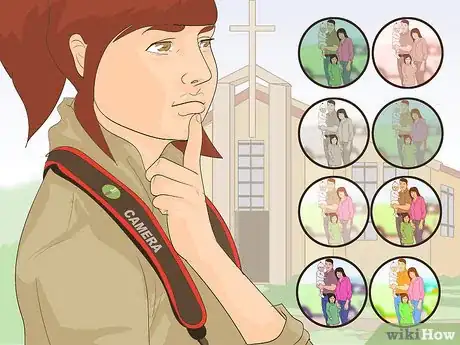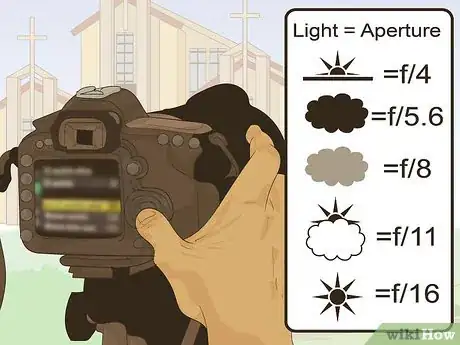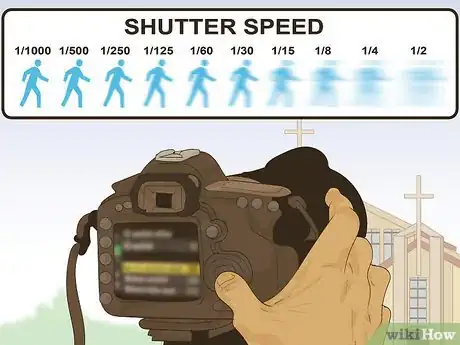This article was co-authored by Vlad Horol. Vlad Horol is a Professional Photographer and the Co-Founder of Yofi Photography, his portrait photography studio based in Chicago, Illinois. He and his wife Rachel specialize in capturing maternity, newborn, and family photos. He has been practicing photography full-time for over five years. His work has been featured in VoyageChicago and Hello Dear Photographer.
There are 12 references cited in this article, which can be found at the bottom of the page.
wikiHow marks an article as reader-approved once it receives enough positive feedback. In this case, 86% of readers who voted found the article helpful, earning it our reader-approved status.
This article has been viewed 31,675 times.
A baptism is an important milestone in a person’s life, and making sure you have quality photos to commemorate the event is important. Although baptism photography can be difficult due to the movement and water involved, with simple techniques, you can prepare for photos, take candid shots, and take staged photos to last a lifetime.
Steps
Organizing Your Shoot
-
1Choose a tone. What are you hoping to get out of your baptism photography--a memento of the event, or a demonstration of your family’s experience? The tone you want will determine how and when you take your photos.
- Tone can include whether your photos are serious or relaxed, playful or solemn. The personality of the people being photographed will also come into play.
- Given that a baptism is a serious religious experience, you will likely need to have at least some serious photos. Keep this in mind when planning poses and shots.
-
2Check church rules. Some churches might prohibit photography, which will require you to take photos before or after the baptism. Different churches will have different policies, and policies may even vary from clergy member to clergy member. Make sure you have permission before your begin snapping away.[1]
- If photos are allowed, ask the church or clergy if there are any rules that should be followed. Some churches do not want artifacts photographed, for instance.
Advertisement -
3Set a color scheme. Set a color scheme for your photos through decorations, food, and even the clothing worn by family and friends, if possible. This does not have to be extensive, but having complementary colors will make your photos appear cleaner and more professional.[2]
- You can create a consistent color scheme by using all pastels in your decorating and your client’s clothing, or you can use two or three specific colors, such as gray, yellow, and navy.
- If a specific color scheme is not possible, you can create some cohesion in your photos by photographing from a similar height, angle, etc.
-
4Take a backup battery. While you will undoubtedly make sure your battery is charged before heading to the baptism, always keep a backup battery on hand in case of an emergency or battery failure. Some older model digital and film cameras go through batteries quickly, so you may want to keep a pack of batteries with you if you have an older-model camera.[3]
- Although most DSLRs come equipped with a replacement battery, make sure you have the correct size and style for your camera.
-
5Check your lighting. Pay attention to the lighting. If the baptism is outside, you will need to adjust your camera’s settings accordingly. If the baptism is held in a dim church sanctuary, you might need to use your flash, which could disturb the baptism if it is not used carefully. Familiarize yourself with the venue to avoid lighting mistakes.[4]
- The more natural light you have, the better your photos will turn out. If the room is extremely dark, ask if you can open a shade or curtain.
Taking Candid Photos
-
1Check your camera settings. Candid photos differ from staged photos in the amount of movement involved. Alter your camera’s settings to capture movement effectively. Most cameras have a specific setting for capturing movement, often indicated by a running figure. Camera presets are a great way to capture candids.
- If you do not have presets, increase your camera’s shutter speed slightly to account for movement.
-
2Take multiple photos. When taking candids, opt for multiple shots. In the age of digital cameras, taking multiple shots is not a waste; instead, it allows you to capture several small snapshots of time. For each moment you want to capture, take between two and four photos.[5]
- This may be a bit more difficult to do if you have to use your camera’s flash. If a flash is necessary, aim for two-three shots.
-
3Search for opportune moments. As you stand by with your camera, scan the event. While you should certainly take photos of the person being baptized, you should also capture the experience of proud parents, excited siblings, or touched friends. Scan the guests in attendance for snapshot-worthy moments.[6]
- Be considerate to guests and churchgoers. Maintain a healthy distance, and work quickly to prevent your subjects from feeling awkward or uncomfortable.
EXPERT TIPVlad Horol is a Professional Photographer and the Co-Founder of Yofi Photography, his portrait photography studio based in Chicago, Illinois. He and his wife Rachel specialize in capturing maternity, newborn, and family photos. He has been practicing photography full-time for over five years. His work has been featured in VoyageChicago and Hello Dear Photographer.Newborn & Family Photographer
 Vlad Horol
Vlad Horol
Newborn & Family PhotographerOur Expert Agrees: When you're shooting a baptism, take a combination of wide shots that capture everyone, as well as close-up shots of the parents in the baby. In particular, pay attention to the parents' reactions during the actual ceremony, as well as any siblings or grandparents who are there.
-
4Keep your camera held high. Candid photos require a quick hand. Have your camera in the photo-taking position as much as possible to capitalize on the time you have available. While hanging your camera around your neck is a great start, you should also keep one hand on the camera as much as possible as you move around.[7]
- If you feel comfortable, you can even survey the room through your viewfinder instead of your naked eye to get a jump on taking a photo.
-
5Get shots of all parts of the baptism. A baptism is more than the moment of sprinkling or immersion. Take photos of people arriving for the ceremony, of family and the person being baptized getting ready, and of the aftermath. All of these candids will provide a window into the experience.[8]
- Make sure you have permission to enter changing areas of the church or venue before you wander around to take photos.
Taking Staged Photos
-
1Create a relaxed atmosphere. A baptism is a happy occasion, so don’t get hung up on taking the “perfect” photo. Instead, encourage your subjects to relax and enjoy themselves. Encourage smiles, hugs, and shows of affection.[9]
- Although you are taking staged photos, your subjects do not all have to be looking at the camera. Encourage looking at the person being baptized, at grandparents, etc.
-
2Take multiple shots in a row. Once you have your subjects arranged the way you want them, take at least three shots in a row. Taking 3 shots will lessen the likelihood of multiple subjects blinking, staring away from the camera, etc. You can give warning each time, or give warning once and take three shots. Experiment to find which approach works best for your subjects.[10]
- Take now, delete later. While you may end up with a camera filled to the brim with photos, it is far better to have too many shots than too few, or one substandard photo per pose.
-
3Give a warning before snapping the photo. Staged photos are not seeking to catch people off guard, so make sure your subjects have fair warning and plenty of time to smile, look up, or arrange themselves according to their preference.[11]
- You do not have to make a large announcement each time. Instead, you can say a simple, “Ready, go!” or you can count to three. Make sure you build trust with your subjects by warning them of impending photos.
-
4Invite the clergy to join in the photos. Baptism doesn’t only involve family and friends, and the photos should reflect that. Invite the clergy involved in the baptism to join in photos, if they’d like.
- In addition to clergy, make the church or venue themselves a part of the story. Photograph the person being baptized beside the river or baptismal font, for instance.
-
5Get solo photos after the baptism. Although your main focus might be capturing family and friends, try to get some photos of the person being baptized on their own. If you are at a christening, you can set the child up on a pew or something similar, and if you are photographing the baptism an older child or adult, you can have them smiling next to the baptismal. Whatever the preferred scenario, make sure you get some photos highlighting the person being baptized and their experience in the process.[12]
- If your subject is old enough to communicate, you can ask them what type of photos they’d like to have and go from there.
Warnings
- Do not disrupt the event itself while taking photos. Be discreet and considerate.⧼thumbs_response⧽
- Be respectful with your photo taking. Do not stand on benches or other church property in an effort to get a good shot.⧼thumbs_response⧽
References
- ↑ http://weddingphotography.com.ph/4957/top-10-tips-baby-christening-photography/
- ↑ https://www.theknot.com/content/engagement-photo-basics
- ↑ http://www.digitalartsonline.co.uk/tutorials/photography/how-prepare-for-photoshoot-tips/#8
- ↑ http://www.popphoto.com/gallery/top-10-photography-lighting-facts-you-should-know
- ↑ http://www.makeuseof.com/tag/9-technical-tips-taking-great-candid-photographs-youll-love/
- ↑ http://www.popphoto.com/how-to/2012/11/photograph-your-family-how-to-take-great-candid-photos-kids
- ↑ https://thedailydigi.com/8-tips-for-great-candid-photos
- ↑ https://expertphotography.com/10-way-take-better-candid-photos/
- ↑ http://www.dummies.com/photography/digital-photography/how-to-pose-and-direct-your-photo-subjects/
- ↑ http://www.nationalgeographic.com/photography/photo-tips/motion-exposure-simply-beautiful-photos/
- ↑ http://www.techradar.com/how-to/photography-video-capture/cameras/14-portrait-photography-tips-you-ll-never-want-to-forget-1320776/2
- ↑ http://lifehacker.com/5712982/how-to-take-great-portrait-photos








































































